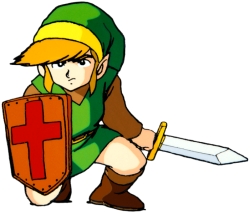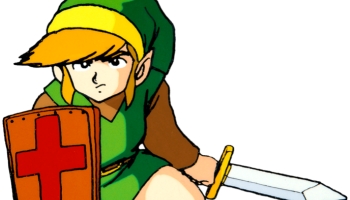 Even though Sega launched the Genesis in 1989 (a year after the console debuted in Japan as the Mega Drive), Nintendo spent the early part of the 1990s without a true rival in the “Console Wars.” Their dominance of the living room was so complete, most people just referred to any video game as “a Nintendo.”
Even though Sega launched the Genesis in 1989 (a year after the console debuted in Japan as the Mega Drive), Nintendo spent the early part of the 1990s without a true rival in the “Console Wars.” Their dominance of the living room was so complete, most people just referred to any video game as “a Nintendo.”
This lack of competition (and its sudden appearance after the release of Sonic the Hedgehog) informed almost every move Nintendo made throughout the decade, including the three items in this edition of Bite-Sized Game History.
![]() You can find a lot of dedicated video game historians on Twitter, and in 280 characters or less, they always manage to unearth some amazing artifacts. Bite-Sized Game History aims to collect some of the best stuff I find on the social media platform.
You can find a lot of dedicated video game historians on Twitter, and in 280 characters or less, they always manage to unearth some amazing artifacts. Bite-Sized Game History aims to collect some of the best stuff I find on the social media platform.
Nintendo had strict guidelines for developers who asked to use religious symbols and imagery in their games, though the most common response from the consolemaker’s certification team was “Don’t.” But that doesn’t mean that certain games didn’t slip through the cracks… including the first three games from Nintendo’s own Legend of Zelda franchise.
While the religious nature of Hyrule goes through the Sages, the Maidens, and the Triforce itself nowadays, the franchise’s earliest games were steeped in religious iconography. Similar to the Knights Templar, Link’s Shield is adorned with a massive cross in The Legend of Zelda, and is the most notable Christian symbol in the game. But there’s also the Magic Book, which gives Link the ability to hurl fire at his enemies. This item was known as the Bible in the original Japanese release, and it too is covered in a large cross.
But all of that pales next to The Legend of Zelda: A Link to the Past. Most of the game’s Christian elements were removed ahead of its North American debut in November 1991, but in Japan, a guidebook published by Nintendo depicts Link in a church, actually kneeling in prayer in front of a crucifix:
FOUND IT!
This is displayed at the top of Chapter 6 in the Japanese-only Kamigami no Triforce – Nintendo Official Guidebooks, the second volume specifically. I found this scan online at the source in the tweet below.
Surprising to see this image is actually real and official. pic.twitter.com/Lwp0exHxYd
— the Well-Red Mage (@theWellRedMage) August 2, 2022
A big driver of Nintendo’s popularity in the 1990s was Nintendo Power magazine. In those days, the consolemaker’s official publication provided information on new and upcoming games that just wasn’t available anywhere else. And it also played host to an almost neverending series of ridiculously cool contests. But one of the magazine’s greatest contests was actually more of a competition.
The August 1991 issue included a two-page spread for a Game Boy Ultimate Design Contest, and it gave readers the chance to decorate a blank Game Boy template with their own custom design. And because it was the early 1990s, and Nintendo Power’s main audience was children, some of the designs were absolutely wild.
The winners were announced four months later in the December 1991 issue, and each had their designs converted into a custom handheld. The entries designed using a pseudo-3D effect and jungle-like mural were certainly impressive, but the First Prize finisher that everyone gravitated towards was a neon yellow-and-black Game Boy with handles.It was extremely minimalist (aside from the handles), but I’ve always wanted to hold it in my hands.
Other submissions filled out the margins of the article, including a high-tech design by Chris Ellsbree that netted a Runner Up prize. While Chris didn’t get to see his creation cast in real plastic, he did win one of three custom Game Boys designed for the contest by the magazine.
Chris also recently shared a few rough draft sketches of his submission with Art of Nintendo Power:
Anything that was sent in to Nintendo Power by readers was never returned. Including contest submissions. However one entrant for this Ultimate Gameboy contest happened to keep his rough draft entries, seen here for the forst time in 30 years! pic.twitter.com/hP60FEnDgj
— Art of Nintendo Power ➡️ Megabit 2022 (@ArtofNP) July 17, 2022
A few years after A Link to the Past and the Game Boy Ultimate Design Contest, Nintendo found themselves in a slugfest with Sega. Rather than go down without a fight, the consolemaker erupted from their corner with a new entry in the Punch-Out!! franchise. Super Punch-Out!! introduced a new class of colorful combatants, but unlike Street Fighter II or Mortal Kombat, the pugilistic parrying was a single-player only affair.
Or was it?
Unlisted Cheats has recently discovered that Super Punch-Out!! included a secret Exhibition Mode and an even-more-secret Two-Player Mode. These hidden gameplay options are fully playable in Super Punch-Out!!, and the codes required to unlock them even still work with the version of the game included on the Super NES Classic microconsole and the Nintendo Switch Online compilation:
While doing some request work, casually found some new cheats in Super Punch-out for SNES. All secret codes in this game uses two-button combinations. Two of them are known: Sound test and Japanese name input. But there are two more. -> pic.twitter.com/ak9xh3fZsc
— Unlisted Cheats (@new_cheats_news) August 8, 2022
And there’s the bell for this edition of Bite-Sized Game History. Thanks to The Well-Red Mage, Art of Nintendo Power, and Unlisted Cheats for a peek at these microstories, and be sure to follow me on Twitter to learn more about the past in 280 characters or less.

